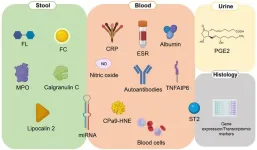(Press-News.org) An estimated 462 million people around the world suffer from Type 2 diabetes, a chronic disease in which the body has problems using sugar as a fuel, leading to a buildup of sugar in the blood and chronic health issues.
New research led by Ayyalusamy Ramamoorthy, a professor at the FAMU-FSU College of Engineering and the Florida State University-headquartered National High Magnetic Field Laboratory, shows how zinc, pH levels and insulin work together to inhibit the buildup of protein clumps that contribute to this disease. The work, which points toward promising avenues for innovative treatments, was published in Communications Biology.
The research focuses on the intricate dance between insulin and the hormone amylin, or human islet amyloid polypeptide (hiAPP). Amylin is a naturally occurring peptide hormone that plays a role in regulating glycemia and energy balance. But human amylin can form amyloid fibers, which can destroy insulin-producing cells in the pancreas.
“At the core of our research we want to understand the complex effects of insulin on amylin’s aggregation and its resultant toxicity,” said Ramamoorthy, who directed the study. “These are factors that are critical to understanding Type 2 diabetes pathophysiology.”
What sets this study apart is its innovative angle on enhancing insulin’s protective capabilities against IAPP’s harmful effects. As the research progresses, new treatments for the millions of people grappling with Type 2 diabetes move closer.
“Amylin is produced in the pancreas alongside insulin and has a tendency to clump into aggregates called amyloid,” said Sam McCalpin, a post-doctoral researcher in the Ramamoorthy lab at the National High Magnetic Field Laboratory. “They’re like the plaques that form in the brain with Alzheimer’s or Parkinson’s disease.”
Researchers are interested in developing drugs to break them up or stop them from forming. For individuals with Type 2 diabetes, amylin tends to cluster into harmful amyloid plaques, devastating the islet cells responsible for hormone production. However, insulin emerges as a potential hero, showing capabilities to hinder amylin’s aggregation. This study unravels the nuances of their interaction, alongside the roles of zinc and pH levels, bringing scientists closer to decoding the cellular intricacies of diabetes.
“There is evidence that insulin can help, but it is not potent enough to directly affect Type 2 diabetes,” McCalpin said. “So, we want to use insulin as a model to engineer more effective treatments in the future.”
The results promise not just groundbreaking insights into this biomedical mystery, but also practical solutions. The research will help drug development aimed at neutralizing amylin’s toxicity, Ramamoorthy said. This could potentially revolutionize treatment approaches, offering hope to those battling this pervasive illness.
Co-authors on this research were Bernd Reif from the Technical University of Munich, Madalena Ivanova from the University of Michigan and Lucie Khemtemourian from the University of Bordeaux.
The project was supported by the National Institutes of Health and the National Institute of Diabetes and Digestive Kidney Diseases.
END
FAMU-FSU College of Engineering research shows how insulin, zinc and pH can block harmful protein clumps linked to Type 2 diabetes
2024-08-22
ELSE PRESS RELEASES FROM THIS DATE:
Fecal, blood, and urinary biomarkers in inflammatory bowel diseases
2024-08-22
The global burden of inflammatory bowel diseases (IBD), primarily Crohn's disease (CD) and ulcerative colitis (UC), continues to rise. Recent data show incidence rates of up to 17.8 cases per 100,000 person-years for CD and even higher for UC, reaching 28.4 per 100,000 person-years. These diseases primarily affect older populations and vary geographically, with higher prevalence rates in highly developed countries. Currently, endoscopic assessment through ileo-colonoscopy is the gold standard for diagnosing and monitoring IBD. However, this approach is invasive and often has limited availability, leading to long ...
ARDD 2024 | What can we do before the "cliff" of aging arrives?
2024-08-22
When exactly does the aging process start? With the aging mechanisms unclear, no consensus has been reached about aging “cliffs”, where our body functions and biological processes just change dramatically, as if overnight.
In 2019, a study published in the authoritative peer-reviewed journal Nature Medicine, based on plasma proteomics data, identified 34, 60, and 78 years old as key time points of aging. In August 2024, Nature Aging, a Nature portfolio journal focusing on aging mechanisms, published the latest findings incorporating comprehensive data including transcriptomics and metabolomics, pinpointing the aging cliffs to the 40s and 60s.
In the biomedical field, multi-omics ...
Hydrogels can play Pong by “remembering” previous patterns of electrical simulation
2024-08-22
Non-living hydrogels can play the video game Pong and improve their gameplay with more experience, researchers report August 23 in the Cell Press journal Cell Reports Physical Science. The researchers hooked hydrogels up to a virtual game environment and then applied a feedback loop between the hydrogel’s paddle—encoded by the distribution of charged particles within the hydrogel—and the ball’s position—encoded by electrical stimulation. With practice, the hydrogel’s accuracy improved by up to 10%, resulting in longer rallies. The researchers say that this demonstrates ...
Precision drug olaparib may be effective without hormone therapy for some men with biochemically recurrent prostate cancer
2024-08-22
The anti-cancer drug olaparib may be effective in treating biochemically recurrent prostate cancer without accompanying hormone therapy for men who have mutations in genes such as BRCA2, according to results of a phase II clinical trial of 51 patients conducted at the Johns Hopkins Kimmel Cancer Center and three other sites.
The study was done of men experiencing signs of cancer recurrence after surgical removal of the prostate, as measured by a high level of the protein prostate-specific antigen (PSA). Following treatment with olaparib, 13 participants, including all 11 who had BRCA2 mutations, had a decrease in PSA of at least 50% ...
Americans face disparities in exposure to tobacco on streaming platforms
2024-08-22
Tens of millions of Americans are being exposed to tobacco content on streaming services, according to new research from The University of Texas MD Anderson Cancer Center. The researchers found that the odds of encountering tobacco products being advertised, marketed or promoted on these platforms increased based on race, ethnicity, socioeconomic status and smoking habits.
The nationally representative study, published today in JAMA Network, revealed an estimated 12.4% of American adults were exposed to tobacco promotion on streaming services. Exposure was highest among those with a high school education or less (16.4%), Black/African American respondents (19.4%), ...
Elinzanetant for the treatment of vasomotor symptoms associated with menopause
2024-08-22
About The Study: In two pivotal phase 3 clinical trials, elinzanetant, a selective neurokinin-1,3 receptor antagonist, demonstrated statistically significant reductions in vasomotor symptoms (VMS) frequency and severity vs placebo in postmenopausal individuals with moderate to severe VMS. Elinzanetant also significantly improved sleep disturbances and menopause-related quality of life vs placebo; the safety profile was favorable.
Corresponding Author: To contact the corresponding author, JoAnn V. Pinkerton, ...
Trends in children’s exposure to food and beverage advertising on television
2024-08-22
About The Study: In this repeated cross-sectional study of children’s exposure to food-related television advertisements, exposure via children’s programming decreased substantially. However, most advertisements seen were still for unhealthy products, and exposure from all programming remained substantial. Findings of more than 90% of advertising exposure not from children’s programming and more than 1,000 food-related advertisements seen per year suggest the need for government regulations based on time of day rather than programming.
Corresponding Author: To contact the corresponding author, Lisa M. Powell, PhD, email powelll@uic.edu.
To ...
Disparities in exposure to tobacco on television or streaming platforms
2024-08-22
About The Study: In this study of the prevalence of exposure to tobacco advertisements on TV or streaming platforms among U.S. adults, disparities in exposure by race or ethnicity, education level, and smoking status were identified. These findings underscore the need for targeted public health interventions and regulation to address these disparities and reduce the impact of tobacco advertisements on vulnerable populations.
Corresponding Author: To contact the corresponding author, Sanjay Shete, PhD, email sshete@mdanderson.org.
To access the embargoed study: Visit our For The Media website at this link https://media.jamanetwork.com/
(doi:10.1001/jamanetworkopen.2024.27781)
Editor’s ...
How thyroid hormone fuels the drive to explore
2024-08-22
Thyroid hormone plays a key role in regulating a range of physiologic functions, including metabolism, temperature, heart rate, and growth. It accomplishes this impressive array of activities by interacting with almost every organ system in the body. Yet despite a long history of research on how thyroid hormone influences different organs, its effects on arguably the most crucial organ — the brain — have remained shrouded in mystery.
Now, scientists at Harvard Medical School have gained ...
Higher thiazide doses shown to reduce kidney stone events
2024-08-22
Higher thiazide doses are associated with greater reductions in urine calcium, which in turn correlate with fewer symptomatic kidney stone events, according to a Vanderbilt University Medical Center (VUMC) study published in JAMA Network Open.
Thiazide diuretics, commonly prescribed to prevent kidney stone recurrence, are drugs that act directly on the kidneys to promote diuresis (urine flow) by inhibiting the sodium/chloride cotransporter located in the distal convoluted tubule of a nephron ...







